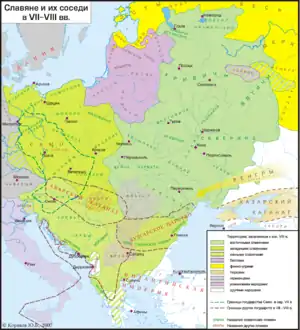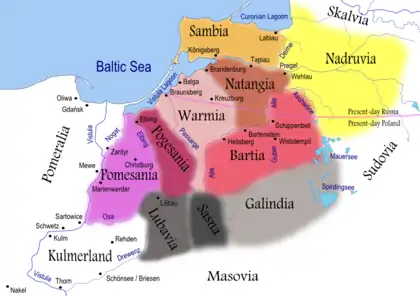Galindians
Galindians were two distinct, and now extinct, tribes of the Balts. Most commonly, Galindians refers to the Western Galindians who lived in the southeast part of Prussia. Less commonly, it is used for a tribe that lived in the area of what is today Moscow.


The name "Galinda" is thought to derive from the Baltic word *galas ("the end"), alluding to the fact that they settled for some time further west and further east than any other Baltic tribe.
Western Galindians
The Western Galindians (Old Prussian: *Galindis,[nb 1] Latin: Galindae) – at first a West Baltic tribe, and later an Old Prussian clan – lived in Galindia, roughly the area of present-day Masuria but including territory further south in what would become the Duchy of Masovia. The region lay adjacent to the territory of the Yotvingians, which is today in Podlaskie Voivodeship.
The name Galind- is probably derived from the hydronym of Gielądzkie Jezioro (53° 52' N, 21° 10' E) in the province of Olsztyn, in what was the very center of ancient Galindia. J. Nalepa (1971) suggested the root *gal- was originally a different ablaut grade of the same root found in Lith. "gilus" – deep, and "gelmė" – depth. The original meaning referred to the depth of the lake mentioned, which is one of the deepest in the area.[1]
Ptolemy was the first to mention the Galindians (Koine Greek: Galindoi – Γαλίνδοι) in the 2nd century AD.[2] From the 6th/7th century until the 17th century the former central part of the Galindian tribe continued to exist as the Old Prussian clan of *Galindis. The language of the Old Prussians in Galindia became extinct by 17th century, mainly because of the 16th centuries influx of Protestants seeking refuge from Catholic Poland into the Galindian area and German-language administration of Prussia.
Eastern Galindians
The Eastern Galindians (East Galindian: *Galindai, Russian: Goliadj, голядь, from Old East Slavic *Golędĭ), an extinct East Baltic tribe, lived from the 4th century in the basin of the Protva River, near the modern Russian towns of Mozhaysk, Vereya, and Borovsk. It is probable that the Eastern Galindians, as the bearers of the Moshchiny culture, also occupied all the Kaluga Oblast before the Early East Slavs populated the Moshchiny culture's area at the turn of the 7th and 8th centuries.[3]
The Russian chronicles first mention Eastern Galindians as Goliadj in 1058. Prince Yury Dolgorukiy arranged a campaign against them in 1147, the year of the first mention of Moscow in the Russian chronicles. Subsequent chronicles do not mention the Eastern Galindians. Nevertheless, the Russians probably did not completely assimilate them until the 15th (or 16th) century.[4][5]
In modern Moscow there is Golyadski lane.
Some people still identified as Goliads in the 19th century.[6]
See also
Notes
- An asterisk placed before the word means that it is reconstructed and is therefore not attested.
References
- Nalepa, Jerzy, 'Próba nowej etymologii nazwy Galindia czyli Golędź.', Opuscula. Slavica 1, [=Slaviska och baltiska studier 9]: 93-115. Lund 1971 Även publicerad i: Acta-Baltico Slavica 9: 191-209. Wrocław 1976.
- Tarasov I. The balts in the Migration Period. P. I. Galindians, pp. 99.
- Седов В.В., Восточные славяне в VI-XIII вв., М., 1982, c. 41-45.
- Седов В.В. Голядь Archived 2011-07-18 at the Wayback Machine
- Tarasov I. The balts in the Migration Period. P. I. Galindians, pp. 100-112.
- Wixman. Peoples of the USSR. p. 75.
